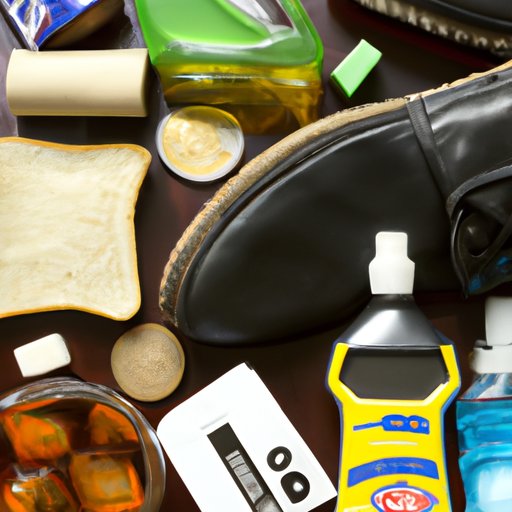Introduction
Tar is an adhesive material that is often found on roads and sidewalks, and it can be difficult to remove. It can easily become stuck to the soles of shoes, so it’s important to know how to get tar off of them. In this article, we’ll explore eight different methods for getting tar off of shoes.

Using a Credit Card to Scrape Off Tar
One of the most effective methods for removing tar from shoes is to use a credit card. The plastic surface of the card can easily scrape away the tar without damaging the material of the shoe, as long as you don’t press too hard. Here’s how to do it:
- Start by wiping away any excess tar with a damp cloth.
- Gently scrape the tar with the credit card at a shallow angle.
- Continue scraping until all of the tar has been removed.
- Wipe away any residue with a damp cloth.
Rubbing the Tar With a Cloth Soaked in Vegetable Oil
Another method for removing tar from shoes is to rub it with a cloth soaked in vegetable oil. The oil will help to break down the tar, making it easier to wipe away. Here’s how to do it:
- Start by soaking a cloth in vegetable oil.
- Gently rub the tar with the cloth until it breaks down.
- Wipe away the tar with a damp cloth.
- If there’s still some tar left, repeat the process until it’s gone.
Applying a Solvent Like WD-40 or Nail Polish Remover
A third method for removing tar from shoes is to apply a solvent like WD-40 or nail polish remover. These solvents are designed to break down tough materials, making it easier to wipe away the tar. Here’s how to do it:
- Start by spraying the tar with WD-40 or nail polish remover.
- Allow the solvent to sit for a few minutes.
- Gently scrape the tar with a cloth or a credit card.
- Wipe away any residue with a damp cloth.
Spraying the Tar With a Citrus-Based Cleaner and Wiping It Away
Another option for removing tar from shoes is to spray it with a citrus-based cleaner and then wipe it away. Citrus-based cleaners are great for breaking down tough materials, and they leave behind a pleasant scent. Here’s how to do it:
- Start by spraying the tar with a citrus-based cleaner.
- Allow the cleaner to sit for a few minutes.
- Gently wipe away the tar with a cloth.
- If necessary, repeat the process until all of the tar is gone.

Freezing the Tar With an Ice Cube and Chipping It Off
If the previous methods haven’t worked, another option is to freeze the tar with an ice cube and then chip it off. This method works best when the tar is thick and sticky. Here’s how to do it:
- Start by placing an ice cube on top of the tar.
- Allow the ice cube to sit for a few minutes.
- Gently chip away the frozen tar with a knife or a spoon.
- Wipe away any residue with a damp cloth.

Applying Peanut Butter to the Tar and Wiping It Away
Believe it or not, peanut butter can also be used to remove tar from shoes. The oils in the peanut butter help to break down the tar and make it easier to wipe away. Here’s how to do it:
- Start by applying a generous amount of peanut butter to the tar.
- Allow the peanut butter to sit for a few minutes.
- Gently wipe away the tar with a cloth.
- If necessary, repeat the process until all of the tar is gone.
Conclusion
Removing tar from shoes can be a tricky task, but there are several methods that can help. We’ve explored eight different methods, including using a credit card to scrape off the tar, rubbing the tar with a cloth soaked in vegetable oil, applying a solvent like WD-40 or nail polish remover, spraying the tar with a citrus-based cleaner and wiping it away, freezing the tar with an ice cube and chipping it off, and applying peanut butter to the tar and wiping it away. To prevent tar from getting on your shoes in the first place, it’s important to be mindful of where you walk and avoid areas where tar is likely to be present.


